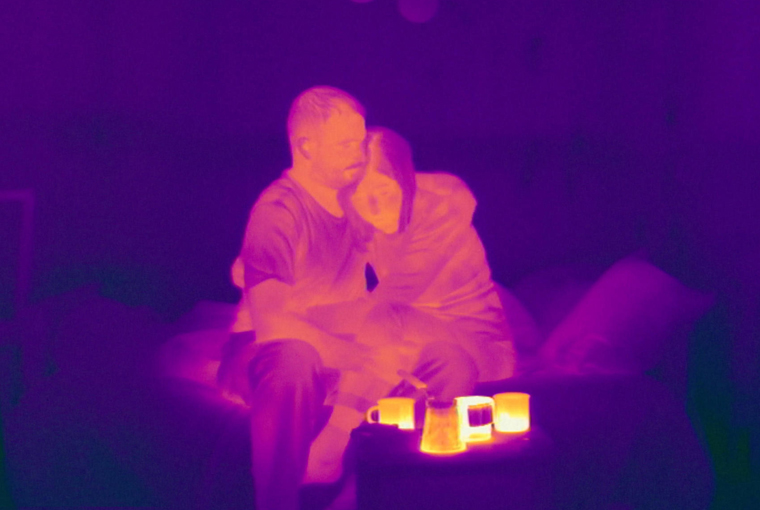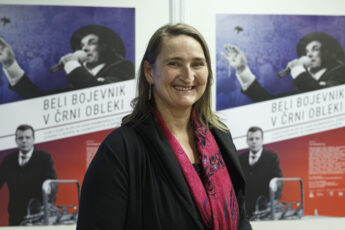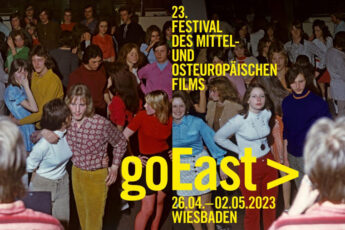An Autopsy of Ordinary People
Valentyn Vasyanovych’s Atlantis (2019)
Vol. 102 (February 2020) by Anastasia Eleftheriou
Infrared cameras depict the unearthing of human bodies, preparing the viewer for the story and the sci-fi approach to follow. Former soldiers Sergiy (Andriy Rymaruk) and Ivan (Vasil Antoniak) work at a steel factory in 2025, one year after the war between Ukraine and Russia has finally ended. Still very much affected by their military past, they continue to dress in combat uniforms and target-shoot for practice. Ivan is suffering from post-traumatic stress disorder and decides to put an end to his life. His suicide is symbolically used to announce the end of the factory’s activity: the workers are collectively informed that new technologies and Ukraine’s economic liberalization have resulted in the closing of the factory. Sergiy takes on a job as a water tanker driver. He distributes water in areas where war pollution has made the water unpotable. This area is referred to as the “dangerous zone”. Within this wasteland, Sergiy meets a group of people collecting corpses from the battle grounds. The team commits autopsies of the dead bodies (which we witness in torturing length and detail), zips them in bags and buries them, as a sort of moral closure of whatever the war has left behind. Sergiy starts following the team around. He meets Katya (Liudmyla Bileka), a former architect, and now a humanitarian activist in the “zone”. She asks him to leave this intoxicated place and follow her to Europe.
The “zone” is not the only link between Vasyanovych’s and Tarkovsky’s work. It might be that in Atlantis the dangerous zone is more literal in that it refers to an existing place of conflict, and yet the film progresses metaphorically: what the war leaves behind are not just ruined landscapes and factories, but human souls. And in that terrible place the soul is tempted to imprison itself, it’s a place without water, a place without hope, an existential zone where one man stands alone trying to make sense of his own existence.
When it comes to the mise en scene, Vasyanovych seems loyal to the Russian cinematographic tradition; the wide static tableaux with deep staging are crucial to the way we perceive the film. Throughout the film, Sergiy is only a tiny spot in a vast-ranging panorama. The very few close-ups are reduced to the depiction of the most vital activities – him eating with Katya, kissing her, or making love to her. In all other shots, it would be difficult to make out a central character. The hyper-theatricality of the shot composition makes the screen work like a painting, in which each field of perspective is used to tell multiple narratives at once. In one scene, for example, we see a van approaching from the horizon. When it comes to a halt in front of the camera, the scene’s action commences, with the van remaining in the middle of the composition throughout.
This compositional shot-making has a tradition in Russian and Ukrainian cinema. Sergei Loznitsa has relied on it for his feature films. In Sculpting in Time,1 Tarkovsky unearths its origins in painting by referencing Carpaccio’s visual techniques:
The point is that each of the characters in Carpaccio’s crowded compositions is a centre. If you concentrate on any one figure you begin to see with unmistakable clarity that everything else is mere context, background, built up like a kind of pedestal for this ‘incidental’ character. The circle closes, and as you gaze at Carpaccio’s canvas your will follows, meekly and unwittingly, the logical channel of feeling intended by the artist, wandering first to one figure apparently lost in the crowd, and then on to the next.
Much like in the description, Sergiy in Vasyanovych’s film is an incidental character. The viewer is constantly pushed to lose Sergiy out of sight, as the “main” protagonist is consumed by the crowd and spatially dislocated from his surroundings. As one factory worker among many, he is indistinguishable and replaceable.
Unlike in Tarkovsky or Loznitsa, Vasyanovych’s cinematic approach is executed so clinically that the effect is unromantic and somewhat cynical. That there is nothing human about war is a platitude, and yet Vasyanovych’s vision of the post-war atmosphere exploits this truism almost voyeuristically. One scene illustrates an autopsy in sickening detail, before the film cuts directly to Sergiy and Katya eating. The only human features of Ivan relate to his diet, his personal hygiene (within the most uncanny and apocalyptic context) and his sex scene with Katya, which still remains very distant and emotionless.
Towards the end of the film, one of the activists tells Ivan that now that Ukraine is cleared of Russian propaganda, it’ll have to be cleared out of the pollution and debris too, but adds that this might take hundreds of years. It seems that Vasyanovych did not want to make a film that would easily please audiences in the West. The scene in which the closing of the factory is announced, may reveal the director’s viewpoint. Yes, Russia did destroy Ukraine, but let’s not fool ourselves, what the West has to offer is equally destructive: the human and ecological misery that comes with liberalism and a free market economy.
Towards the end of the film, we see Ivan and Katya through the same infrared camera used on the unburied corpses in the beginning of the film. Does that mean that they are alive and that they “found love in a hopeless place” (as a critic rather naively observed)? One could also claim that the juxtaposition with the dead corpses signifies that they are already dead. Katya then asks him to follow him in order to live safely. He replies, “I used to live like ordinary people”. His words sound more and more pessimistic as the film comes to a close. Ivan and Katya stand alone, two humans in front of a factory which seems like a monster, a representation of something inhuman and evil imposing itself on their landscape. The title could also be interpreted in this way, Atlantis being the ruinous leftovers of Plato’s ideal state in the Republic. When someone in some distant future will look back at the films of today, they’d better run into this one. For it is hopeless times we live in, and embellishing images of war with emotion is yet another tool of manipulation.
References
References
- 1Andrey Tarkovsky, Kitty Hunter-Blair. Sculpting in Time – Tarkovsky The Great Russian Filmmaker Discusses His Art. 1987, University of Texas Press, p. 50.




Leave a Comment